#queer cinema at its peak angst
Explore tagged Tumblr posts
Text
2x3 Filmmaking Analysis
Editing and cinematography breakdown of the purgatory and mermaid scene in The Innkeeper.
I haven't talked much about editing in all of my previous breakdowns of this season, but I want to start talking about that, and I'm starting with this scene. The whole of 2x3 contains exceptional editing between what is happening in Ed's gravy basket purgatory and the real world.

We start with Stede on the stairs, quiet, only a deep inhale of despair is heard, the heartbreak already evident on his face. He holds up a lamp, one of the only sources of light in the "reality" scenes. Lighthouses and golden lighting in general have been used in both seasons to symbolism the love between Ed and Stede. Stede is literally carrying this light with him, and he sets it down next to Ed's head shining the light onto him. Stede is the one who puts the glow on Ed's face.

The editing then cuts to Ed in Purgatory as he hits the water, a giant light behind him, but he starts to sink away from it, becomes surrounded by water, recalling back to 1x4 when he talks about how he feels like he is just treading. Water shows Ed's mental state: he's expressed in the past that he feels like he's drowning, he wants to stay at sea forever, be the bird who doesn't touch ground, etc.
We end this shot with Ed's bare feet the most visible in the dark blue abyss of the ocean. And in a direct parallel, the next edit is to Stede's feet - which are wrapped in BLUE-dyed fabric, with RED lining - walking into the waterlogged cabin. This immediate cut between their two feet in water shows how Stede is meeting Ed in both worlds. They are together in the water, in the deep blue depth, their connection only picks up from there.
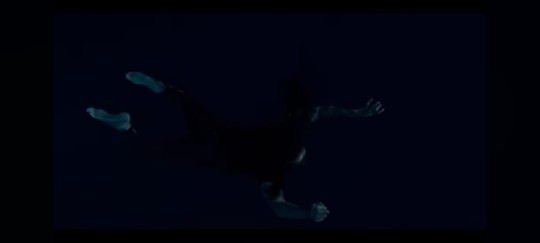

While talking to Hornigold, Ed professed that he didn't think anyone was waiting for him. And he still has that mindset as he starts to sink.
Stede sits quietly down next to Ed, lovingly calls him a nut, and debates about taking the cloth off of Ed's face. We know Stede to be a boisterous man, not afraid to talk, but his voice is quiet here, the sentences short. He covers his face with his hands, hiding and comforting himself. Stede is rendered speechless when he's faced with earth-shattering grief and this all encompassing sorrow tells the audience just how much pain Stede is in.
Stede pulls off the cloth from Ed's face, once again taking a shaky inhale of breath to prepare himself, and the show cuts to Ed's eyes opening in the water as he starts to fight, pulling on the rope tugging him down.

The editing takes us back and forth between Ed struggling with the rope in Purgatory to his fingers and hand twitching as he fights in the real world, all voiced over by Stede's mournful apologies to Ed. When Stede's voice comes through to Ed, it sounds muffled, like it has to travel through a tube to get to him - through the water and Ed's coma-induced brain.
As soon as Stede touches Ed's hand in the real world, squeezing it, Ed stops sinking further into the watery depths, and instead his focus is before him where a large light has appeared. This editing shows how Ed feels Stede's presence, not only his voice but how the touch grounds him, or at least prevents him from further sinking.
Stede's voice changes here, getting louder as he yells at Ed to come back to him. The quiet grief is replaced by twinges of hope, the deep sobs escape in raspy pains of anguish.
The light first appears to Ed in Purgatory when Stede holds his hand, and as Stede starts to hammer on his chest, to try and bring some life into him, the scene cuts to Ed seeing movement in the light as Stede in mermaid form starts to swim closer.


The scene then goes from both POVs to just Ed's. We see the rope come off as he decides to live. We can hear the muffled cries of Stede breaking in from the real world, and we see a sequence of scenes from the first season of Ed and Stede as Ed remembers all of their moments together.
Right when Stede pounds his chest for the last time and says he will never leave again, that's when the mermaid version of him comes into full focus. And we again spend time in just purgatory, in Ed's POV.
Mermaid Stede swims up to Ed and stops right in front of him, not touching, not pulling him to the surface. Instead he just stays there with him, smiling, and letting him know he's there. It is Ed who decides to live, and I think that's an important distinction. Stede doesn't save him, he just exists in Ed’s space, floating in the water, and ushering in light and hope.


The last moments are Ed waking up as Stede cries, their hands gripping onto each other in a symbolic meaning of them choosing each other, Ed choosing life. The last shot is no longer the fantastical purgatory place with bright white lights and blue water that symbolize the all encompassing pressure around Ed. Now it's the real world, where Stede is wearing blue and red, his feet are in water, and his lamp shining the light onto Ed. Their hands are clasped together as Ed takes a large breath of air - coming to life. Reborn not on the seas or water, but the boat that they fell in love with each other on.
We see continued symbolism throughout this scene. The red representing their love, the lamp set next to Ed by Stede and the bright light in the ocean that mermaid Stede brings in, showing the light and hope in Ed's mind now. And the blue colors that Stede wears, and Stede stepping into the water-logged cabin, showing how he is joining Ed in his world. And when Ed chooses life, all of those things are there to greet him but not in the bright fantasy colors of his mind, but rather the muted colors of the real world.

The cinematography of purgatory is lighter in tones. The ocean is dark until Stede brings in the white blinding light, which then surrounds them, turning the water around them to a soft blue. On the other hand, the lighting on the ship is darker. The brown wood of the cabin are just shapes in the background. The only light is from the deep orange lantern glow. The contrast in colors representing the fantasy from reality.
Every single cut in the editing has a purpose. Each action that happens in the real world is immediately reflected in the purgatory mindset. Not a single shot wasted. This scene is beautifully put together in all aspects of the filmmaking.
Hand gif credit
#ofmd#our flag means death#ofmd spoilers#ofmd s2#ofmd season 2#our flag means death s2 spoilers#stede bonnet#ofmd stede#ofmd edward teach#gentlebeard#blackbonnet#queer cinema at its peak angst#cinematography#ofmd season two meta analysis#ofmd meta#meta analysis#editing#The Innkeeper#ofmd 2x3
271 notes
·
View notes
Text
guys i just like, sit here and Cry thinking about the quality fucking content we got with 4x04. like i can’t even articulate the sheer Notebook level turned dark romantic drama and angst we got between elliot and tyrell. it’s truly the level of dumbassery, miscommunication, tension, good writing & rawness i NEED in a ship
not only is it fucking christmas, which like, is explicitly mentioned and verbalized which holds so many feelings & symbolism in and of itself (🙏🏻), but like... there’s so much more
tyrell talks to both robot and elliot in this episode, blatantly and individually. he turns to talk to each respective one (like the split scene w robot sitting on the guardrail w him and elliot walking off down the road) and that is just ...Peak fucking Poetic Cinema in terms of symbolic represention that tyrell knows who he’s talking to in reference to elliot’s alters. he knows elliot, and he knows when he’s “a different person” (quoting his confusion in s3 when he finds out about his alternate personalities). so like not only does that exist, but it’s also never actually been presented that way with any other character, so it’s really fucking unique and special imo.
then comes the fucking DIALOGUE that just obliterates any chance i had at being normal ever again. like “just be honest with me i can take it” “what is the point of all this?” - not only is elliot like, panicking & clearly deflecting bc he doesn’t want to open up and answer the question bc he’s terrified, but he doesn’t even dismiss the obvious romantic undertones? he knows exactly what tyrell means. it’s just romantic context. and it doesn’t even stop there. the most telling bit for me is “just answer the question, did you?” “tyrell you didn’t make it easy—“
YOU DIDN’T MAKE IT EASY
like is that not the most clichéd fucking emotional conflict buildup to a full blown lover’s spat you’ve ever heard??? YOU DIDN’T MAKE IT EASY- again not even dismissing that he still does regardless? or could? or tried to? it’s all just so seemless & romantically coded conversation and i gotta give a big 👏🏻 to sam esmail for it. he screwed us in the end but he said fuck hetero lives and made tyrelliot so blatantly romantic.
anyway tyrell does get his comeuppance and smack of reality for being an intimidating and capitalist vulture in the past when he realizes that elliot isn’t exactly head over heels for him, but they’re still such complimentary characters in the sense that the conversation itself & who tyrell is by nature still pushes elliot in ways he needs. he pops elliot’s safe bubble & forces him to admit the emotionality he does have, process it, and decide for himself shit.. maybe i do care more than i let on- maybe i can’t shut myself out from feeling.
it’s just.. when spending time together, it’s narratively impossible not to let them be each other’s reality check and foil (they got one ep together and all of this came flooding out as a result! like proof!!). to me, that is when you know you’ve struck gold w a pairing. and that’s also incidentally why creators chicken out & never actually put certain characters who have natural queer chemistry in scenes together, bc that chemistry is so obvious and undeniable that it could easily trump other narratives they’re trying to sell- like for example, making their characters heteronormative. i’ve seen it happen literally time and time again and i don’t get it bc they created these characters and yet they’re terrified of their possibilities??? anyway hlfkfk
like the “i’m going” “yeah.. go elliot..” “i will!” “yeah good” lmfao. hilarious bitter break up vibes? sign me the fuck up. quintessential romantic drama dialogue. and then they end up yelling at each other hlflgkkfd. like aside from interactions w robot, when has elliot ever actually cared enough about something to even flinch? and here he is screaming? with nothing between them but dead silence??? it’s fucking beautiful & this is such a CHARACTER-CENTRIC episode i wish the whole god damn show had the vibes of this ep!! this is my JAM and it was an absolute goldmine
and on top of it all, as an audience you know that elliot is beginning to lose himself (having gone totally off the deep end with fucking over olivia’s entire life) and yet there tyrell is, the key, screaming through the distance (that elliot both physically and metaphorically created) between them that he’s so in his own head that he’s losing sight of reality and what really matters: people, things, direction, feelings. i just.............. speechless.
tyrell is absolutely paramount to elliot’s sanity and emotionality and i mourn the fact that sam underused him. bc he creates such a centerpoint for elliot. and in giving a nod to the typical hero and villain dynamic, it works so well but with such a powerful twist of turning that dynamic on its head. they don’t actually hate each other and instead have grown fond of each other.
like elliot comes around, opens up and speaks softly again, admitting he shouldn’t and wouldn’t leave tyrell behind, that he is individually important and worth coming back for (something tyrell has never heard before from anyone! something he’s been searching for this whole series!) - building tyrells walls back up from nothing. and tyrell got a moment to be strong, & speak his mind/feelings which brought elliot out of his compulsive loop and took a sledgehammer to the concrete walls around his heart.
anyway i could go on for ages and also watch an entire show of just the two of them but this post is a nonsensical mess so take it how you will i’ll just be over here crying hlrlrkjfj
125 notes
·
View notes
Text
HUSTLE & BLOW - My Review of SAUVAGE/WILD (3 1/2 Stars)

I’ll never forget the buttplug scene. Not because it’s disturbing and somewhat graphic, but because it prompted my favorite indignant Writers Guild walk-out I’ve ever had the pleasure of witnessing, and there have been many. As soon as things got hot and heavy, a woman across the aisle from me stood up, waved her arms furiously, and muttered, “I CAN NOT E-V-E-N!!!” And here, my friends, is why good, challenging films can’t have Oscars!
The delicate sensibilities of professional writers notwithstanding, SAUVAGE/WILD, the debut feature of writer/director Camille Vidal-Naquet, traces the downward spiral of a young, gay street hustler in small town France and it pulls no punches. It’s a dour, violent, explicit, drug-fueled tale of a man who for better or for worse (and let’s face it, he leans into worse), lives life on his own terms. The unnamed hustler called Leo in the credits and played by the remarkable Félix Maritaud (KNIFE + HEART, BPM) spends his time turning tricks, dancing in clubs, squatting in crack dens or sleeping on curbs. Leo pines after a fellow hustler, dynamically played by Eric Bernard, who does “gay for pay” only and has attached himself to a wealthy, older gentleman.
Leo also faces some looming health issues yet charges forward from one horrific incident to the next. Vidal-Naquet, however, manages to instill this upsetting film with a lot of unexpected tenderness, whether it’s coming from his crush, a fellow gay hustler, and in one breathtaking moment, a female doctor who allows Leo the space to speak his truth. The film feels like a direct descendant of the late, great Agnès Varda’s 1985 film, VAGABOND, which told the story of a homeless female drifter. Both films share the DNA of a propulsive docu-style of storytelling and a difficult but empathetic lead character. I’m also reminded of the New Queer Cinema films of the 1990s, such as HEAD ON and THE LIVING END, which also pointed its cameras at people living on the edge.
Despite the similarities, SAUVAGE/WILD has its own voice. It’s harsh and brutal, but Leo has agency and owns every decision he makes. The world may want to fix him, but he has other plans. He’s aware of the horrors, but also feels alive whenever he charges into the flames. One person’s existentialist nightmare may be another’s paradise. Think of Alex in A CLOCKWORK ORANGE. After all of the brainwashing, the change in appearance and attitude, don’t you think he was way more interesting and fun as a practitioner of the old ultra-violence? SAUVAGE/WILD risks asking this same question. You may not like Leo’s decisions or actions, but they’re his, not yours.
The film also benefits from some incredible cinematography by Jacques Girault. Yes, many scenes feature the usual handheld camera, but then we’re thrust into evocative strobing images in a club, or beautifully framed scenes by the park roads where the hustlers work. Still, it’s not a film for everyone. It often feels stuck on repeat as Leo’s life goes from one dark moment to the next, and it has plenty of nudity and some really aggressive sex. It also has plenty of bloody violence, yet spares us the most intense of these episodes, showing us only the aftermath. Did I mention there’s lots of sex? If on-camera thrusting and blow jobs aren’t your jam, you might want to go down the hall and watch MISSING LINK instead. And yes, that buttplug scene may end up as notorious as the peach scene in CALL ME BY YOUR NAME, but for me, its unforgettable quality lies in how Leo responds to every humiliating demand of his sociopathic johns.
Credit goes, however, to Félix Maritaud for injecting his character with empathy and heartbreaking fragility. He allows that vulnerability to peak out in key moments, yet it never feels overly sentimental. It’s as if he’s letting a little of angst out so he can steel himself for whatever comes next. Leo also has no issues kissing his clients, a line most hustlers won’t cross. It’s as if his character will accept love and affection anywhere he can get it. Camille Vidal-Naquet reportedly spent a few years researching the lives of hustler in order to write his screenplay and it shows in the ways they interact with their customers. You may wince at the methods they employ to drug and rob one client, but it also feels very believable.
I admired this film’s unblinking determination to give us something new in this gritty, tried and true genre. Leo lives for the moment, seemingly relishing not having a road map. Not everyone will want to follow him in his freefall, but, as it turns out,
I CAN E-V-E-N!
1 note
·
View note
Text
Filmmaking analysis time!
How blocking and the use of rope and lighting shows the diverting threads of Stede's and Ed's paths in 2x7.
Rope Symbolism
Thread/rope/twine are used throughout this episode to symbolize the reeling in of Ed to the "normal life." My meta analysis of that can be viewed here. Or summarized in the below paragraph.
Something about the twine/rope spread throughout 2x7. First we see Ed use it to wrap up his leathers and dump it in the ocean. Next he cuts up two pieces of twine to add as flourish on the breakfast tray. And then while he's watching the fisherpeople, the camera focuses on the fish being extracted from the sting. And finally, while Ed and Stede talk, Ed tells him that he's leaving to become a fisherman, a large rope is in front of them the whole conversation. The twine symbolizing being reeled into the "normal" life: the dumping of his Blackbeard persona, the domesticity of breakfast in bed with his boyfriend, the fish caught up in the string being freed. But then the giant rope symbolizing the unraveling of the relationship with Stede and piracy.
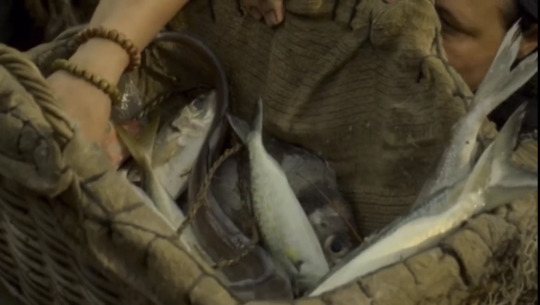

Blocking
Keeping this thought in mind, let's now look at the position of Stede's and particularly Ed's body during the conversation.
At the start of the conversation, rope is shown on the left side of Ed, away from Stede. Ed is standing at the top of the platform, facing sideways and playing with the greenery. Stede is below, excited about his day, and he runs up the platform to be even with Ed.

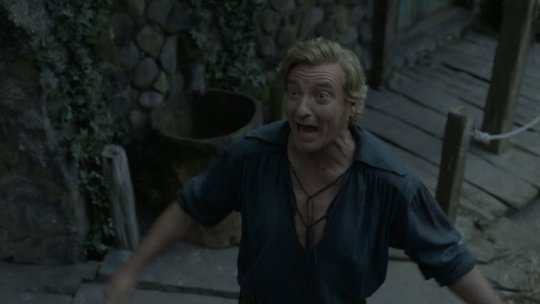
Ed moves over and stands in front of the post, first facing away from Stede completely then turning to face forward with his head down, not looking at Stede. When Ed states, "I'm happy for you, I really am" he is physically walking away from Stede, not looking, showing with his body the exact opposite of his words.

When he comes to rest, his hands are on either side of the post, the rope is in front of him, one going towards Stede and one away, representing the two diverging paths Ed can choose right now.
Ed then leans forward on the railing, bringing his body in close, like he's covering himself in that metaphorical blanket he uses when he's being vulnerable. But Stede also leans on the railing, leaning toward Ed, matching his body language and keeping close to let him know he is there but not touching, not crossing that boundary without consent.

Stede then offers an olive branch. "Well, you know this can be whatever we want it to be." And the men continue facing forward but their heads are turned and are looking at each other as they speak.
The shot is tight, not showing the rope right now, instead it is an intimate moment and mainly faces are shown. We see all of Stede's head and shoulders when he speaks, showing that he is all in, he will take anything as long as Ed is by him. Breathing the same air. The top of Ed's head is cut off, which is a running theme and camerawork throughout this season to show the mental turmoil that Ed is going through.
They stand up straight again when Ed announces he's leaving - no longer on the same side and in defense mode. And the fight starts to escalate. They turn toward each other the first time and Ed even leans forward, taking a half step as he gestures and talks about catching the fish and being a fisherman now.

Ed starts to walk away once Stede says "the fish was whatever." Ed moves away from the pillar, the two diverging ropes and toward the one that leads away from Stede. He has made up his mind which thread he is going to follow. And the camera chooses to focus on Ed in the foreground because this is his decision, his choice, and Stede is blurry like the confused state of bundled ropes at this quick turn of events.
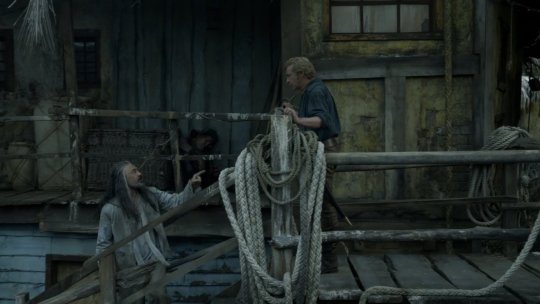
Stede stops at the top of the stairs where all of the rope is wrapped around the pillar in an organized mess. His path ends here, in this tangled mess of emotions, confused and weighed down by the heaviness of piracy and the past hours? Days? Where things have turned, his own thread that he has been following.
Ed no longer has that weight dragging him under. The twine reeling him to the normal life has triumphed as he cuts ties with the Blackbeard persona, the pirate life, and now Stede.
Lighting/Cinematography/Camerawork
The lighting in this scene (since Ned Low crashes the party in 2x6 has mostly been off.
You can literally see the light change from the warm glows of red and purple to the green tint in the above clip. As talked about in my analysis of cinematography used in 2x6 and 2x7 to show Stede's and Ed's emotional journey, green lighting/undertones are used to show the audience that something is off. This color grading is an abrupt departure from the usual coloring of the show and that is done on purpose here.
The sky is grey, muted, hints of that same green undertones faintly there, because this is reality hitting them in the face. This isn't the bright reds and purples of their love, the golden hues of them being each other's lighthouses, this is the cold grey of reality crashing down around them, a setting sun in this part of their relationship. Their body language is aggressive, scowls, raised voices, insults, and pointed fingers taking over from the dreamlike quality of a mermaid and ocean in bed together.

Lens flairs are often done from dramatic effect (unless you're JJ Abrams and they are just your style.) Most of the time, films are shot to avoid them, so when you see them your eye is drawn to it. And a very large one is purposely used in this scene. It is situated right between Ed and Stede and extends into the rope below while Ed is telling him that he wanted to take it slow. It punctuates his point, like a dawning of realization of the truth to the audience and Stede. This is the first time Stede is hearing about this and it hits hard.
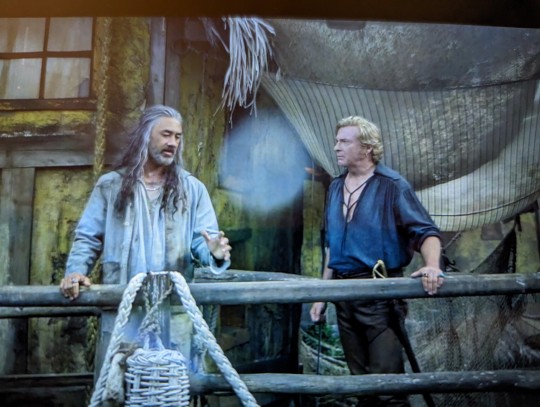
The camera angle changes to just Ed when the truth comes out because this is his truth he needs to tell. Stede is not muddying the shot but instead where his shoulder or arm would be is the pillar with the tangle of ropes, showing both the knots Stede's stomach is tying itself into as well as how this speech is the thread leading to Stede.
(I would show a picture here but I can only attach 10, so imagine it!)
They are also dressed in opposite colors as when they first met. Then Stede was in light and Ed in his all black Blackbeard leathers. Now Ed is the one wearing light greys and Stede in is black and dark blue, carrying a sword. Their roles have switched.
Overall, all aspects of production come together, from the cinematography, clothing, props, blocking, etc to show just how off this scene is, how unsettling reality can be. And how we have different threads of paths we can take in our lives if only we are brave enough to grab hold of the right one.
While Stede at first heads up to Ed at the beginning of the scene, tries to save the situation, he's on one side of this thread. Ed straddles the cords and ultimately decides to break free of the thread that was leading him away from his beacon of light. He heads down and away from Stede, and descends onto a path by himself, and just like the fish he saw extracted from the twine earlier that day, just like the twine he placed on the tray in his panic, there are no threads left to keep him anchored.
#our flag means death#ofmd#ofmd s2#ofmd spoilers#our flag means death s2 spoilers#ofmd season 2#meta analysis#ofmd season two meta analysis#ofmd ed x stede#ofmd edward teach#ed x stede#gentlebeard#blackbeard x stede#blackbonnet#ofmd stede#stede bonnet#edward x stede#queer cinema at its peak angst
116 notes
·
View notes
Text
OFMD filmmaking analysis!
The camerawork, cinematography, and blocking during Blackbeard and Frenchie's "impossible bird" conversation at the end of 2x1.
There is so much to discover and deep dive with the scenes between Blackbeard and Frenchie.
Since the ship does not physically move this season, the production crew had to utilize other techniques to show the rocking of the ship on the ocean. From what I've observed, the primary one for on the main deck is to move the rigging and sails like the wind is blowing through them. They also move the camera in an up-and-down or side-to-side motion to simulate the oceanic waves; that is the method they use in this scene, especially since they are on the front of the ship and no rigging can be seen.
This motion of the camera in this shot is not only used to simulate the waves, but also to show the mental state of the characters. This headspace (figuratively and literally) camera framing is used throughout the season and especially on Blackbeard in the first three episodes (as talked about in my other analysis of the "this ship is poison" scene in 2x1.)

The scene starts with an overhead establishing shot tilted to the side, making the audience already feel off-center. Frenchie crawls out of the hold - showing him lower physically than Blackbeard (I talk about this same framing and camerawork between these two in 2x2 here) and stays in front of the door- leaving him room to escape. Blackbeard stands on the opposite side of the bow, with his hand on the railing.

They then cut to a two-person frame with Blackbeard large and in focus in the foreground and Frenchie small and out of focus in the background. This closeness to Blackbeard means the audience can see every micro expression, witness the dead eyes, and hear every shuttering intake of breath and shaky speech. It is intimate and the audience can sense all the pain and discomfort Blackbeard is emoting.
The camera moves up and down as Blackbeard makes the speech about a bird who never touches ground, very clearly showing that he is that bird who never wants to land. The floating camera cuts into his forehead while he speaks because just like how Blackbeard's head is breaking the frame barrier, his mental health is broken.
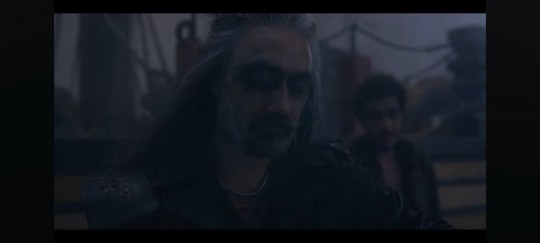
As Blackbeard speaks, a heavy fog starts to roll in from the sea, surrounding him. It alludes to the fogginess of his brain/emotions as well as the shrugged on public persona of Blackbeard. He is wrapping himself in this bleak cover, but his Ed self is still hidden underneath, the fog isn't thick enough around the shroud of the Kraken persona. Like the cover of the robe or blanker fort, but the fog/Kraken smokescreen doesn't offer a comfort from the harshness of the world, instead only offering the pain and self-destruction of his inner self.
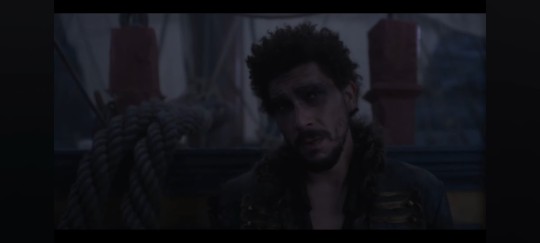
The other major shot in this scene is of Frenchie. He is center framed in a clean shot; Blackbeard doesn't dirty the shot because he isn't important here, the camera is focusing on Frenchie taking in this information, revealing his emotions and mental state, and ultimately serving as the conduit of theaudience. The framing is farther away than with Blackbeard, still a medium shot but it doesn't move to allow Frenchie's head to be cut off by the frame. The camera is moving more side-to-side motions than up and down, still offering that discomfort of the situation but it suggests a different mindset than Blackbeard. Frenchie's mind isn't broken (his spirit on the other hand) he boxes up his emotions here, so he is just taking in Blackbeard's words, just like the audience is. Listening to the contradictions and trying to find out what is really being said.

The cinematography of this scene is also something worth looking at. We have the light of the ship behind Ed, something he never turns toward or seeks out. Instead, he is looking at the vast darkness in front of him, it enshrouds him and complements his mental state. The only time he looks toward the light is at the moon when he addresses Stede-symbolizing the light in the darkness.

During this entire conversation with Frenchie, Blackbeard does not turn around to talk to him. Instead, Blackbeard's broken words and grieving are spit out into the dark abyss of the ocean in front of them, the wind carrying them back to his new first mate. Ed chose to be vulnerable with Lucius (and some of the crew - though there is an argument that most of that was in a disassociate state). He cried and let all his heartbreak and despair out in front of Lucius. Only to have to get "rid" of that vulnerability by pushing him off the ship. He doesn't turn around here because he won't let anyone else see that side of him again, won't let them leave/hurt him, won't let Frenchie see the state of his distress.
The end shot surrounds Ed in the dark blue of the sky, only the moon lighting the way as the camera pans to Stede looking up into the same night sky. The symbolism of the light in the darkness for both characters, even if their words "F you, Stede Bonnet" and "Good night, Edward Teach" evoke warring emotions.
Overall, all forms of production, from cinematography, camera framing, blocking, and especially the acting (give Taika awards for this alone - I have never seen him act like this in any other role) are used to show the mental state of the characters.
Note: I purposefully use the name Blackbeard here whenever Ed is in this mental state, though "Kraken" might be more accurate.
#ofmd#our flag means death#ofmd spoilers#ofmd s2#ofmd season 2#our flag means death s2 spoilers#ofmd edward teach#ofmd frenchie#kracken era blackbeard#blackbeard#ofmd season two meta analysis#ofmd meta#meta analysis#queer cinema at its peak angst#cinematography#this camerawork is so beautiful#camerawork#camerawork analysis#frenchie ofmd
37 notes
·
View notes